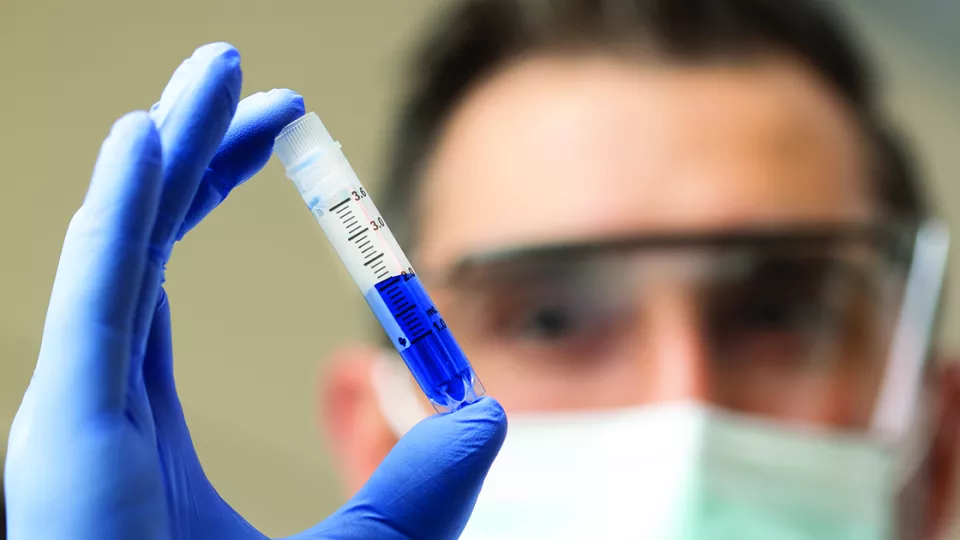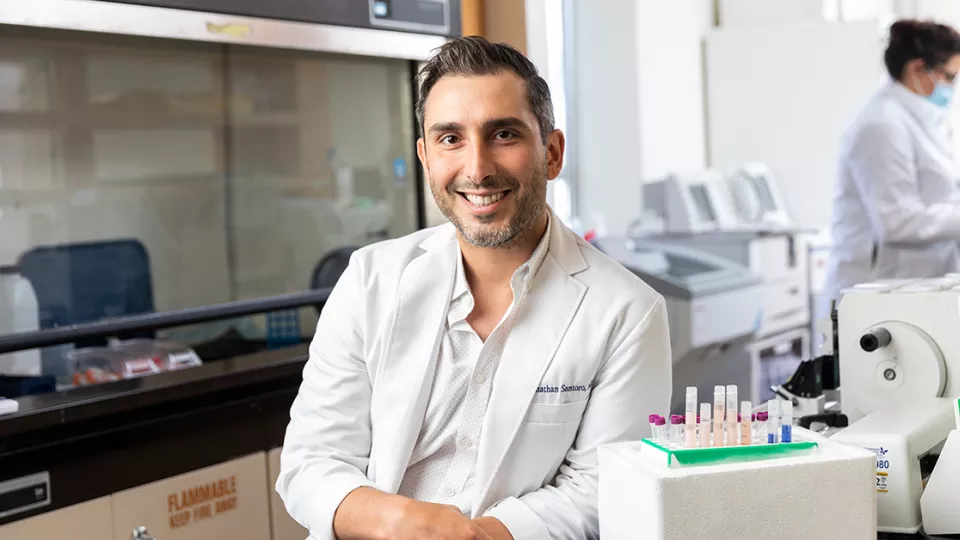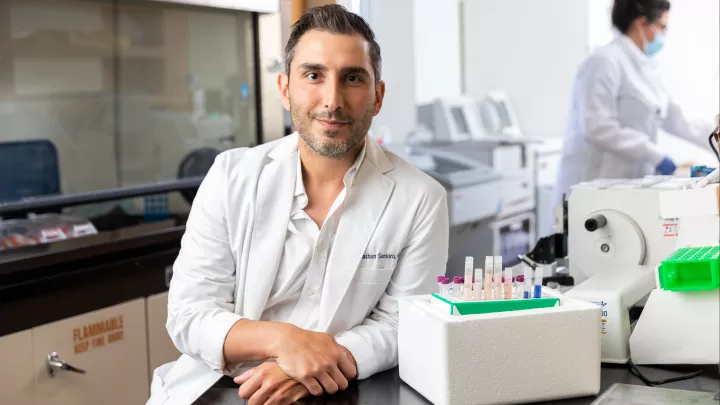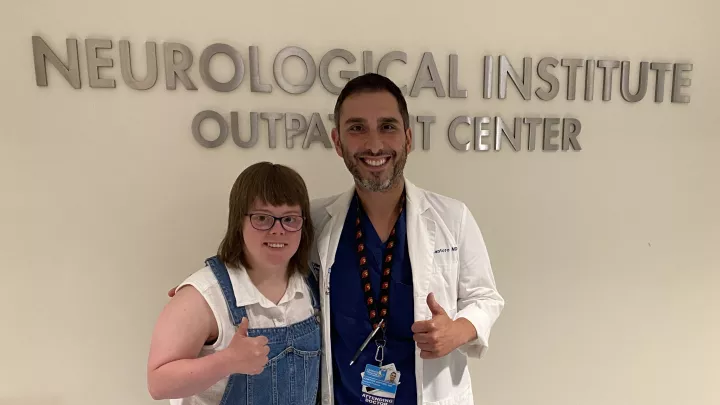
Under the Microscope: Unlocking the Mystery of Down Syndrome Regression Disorder
“It’s like living with a ghost.”
“There’s a stranger in my house.”
“My child died and another child replaced them.”
That’s how families describe their experience with Down syndrome regression disorder (DSRD)—a rare condition that causes previously high-functioning young people with Down syndrome to suddenly lose their ability to communicate, dress or feed themselves, use the bathroom or even sleep. Long assumed to be a psychiatric condition, or even early-onset Alzheimer’s disease, DSRD has been the subject of virtually no research—until now.
Since 2019, Jonathan Santoro, MD, a pediatric neuroimmunologist at Children’s Hospital Los Angeles, has been developing a novel treatment protocol for this devastating disorder. Recently, he launched the first clinical trial in DSRD—a National Institutes of Health-funded collaboration between CHLA and the University of Colorado.
Dr. Santoro talks about how his research came about, what this new trial means for patients and why he’s in a race to find answers.

What is the need for research in DSRD?
It’s critical. This is a condition that was first described in 1946, in a paper on 26 patients with what was called catatonic psychosis. But after that, there was essentially no research on it for 70-plus years. Patients have been misdiagnosed with schizophrenia, early-onset Alzheimer’s disease or late-onset autism. Basically, families have been told, “This is just part of Down syndrome.”
How did you start studying this condition?
When I began seeing patients with this severe, unexplained regression, my question was: If these patients didn’t have Down syndrome, what would we be doing? Because of my training in neuroimmunology, my natural reaction was to perform a comprehensive workup for inflammatory conditions affecting the brain. And when we did that, we found inflammatory markers in the cerebrospinal fluid. We then treated those patients with high-dose steroids and an immune therapy called intravenous immunoglobin (IVIG). Since 2019, we’ve seen 200 patients from 32 states at CHLA—by far the most in the country.
Your first patient had a dramatic response to treatment. What happened?
This was a previously high-functioning young man who had been in a lot of mainstream classes at school. And then, out of the blue, he completely regressed over a few weeks. By the time I met him, he hadn’t spoken or moved in two years. The family had been flying all over the country to see Down syndrome specialists but had come away with no answers.
We treated him, and three weeks after his first IVIG infusion, he was talking and running down the hallway. It was really striking. Seeing him after treatment was like meeting a different person.
What have your studies found so far?
We’ve discovered that about 20% of patients have standard inflammatory markers in their spinal fluid, and 85% of those patients respond to treatment, particularly IVIG. Interestingly, individuals without those classic inflammation markers also respond to IVIG, at a rate of 70% to 75%.
What we’re doing in our research now is examining the spinal fluid on a deeper level—a protein level. We’ve found that the spinal fluid proteins in individuals with Down syndrome regression disorder are the same proteins we see in patients with inflammatory conditions like multiple sclerosis. In other words, the types of inflammatory proteins that can exist in the spinal fluid are actually there—even in patients who test negative on standard commercial tests.
Does that mean that DSRD is an inflammatory disease?
We don’t know yet. But there is mounting evidence that this is an inflammatory disorder that is potentially treatable. We also know that individuals with Down syndrome are already predisposed to other autoimmune conditions, such as Type 1 diabetes, and it makes sense that the brain could be predisposed toward autoimmune disease as well.
I think it’s complicated, though. Not every patient has a dramatic response to treatment. In neuroimmunology, it’s not one-size-fits-all. We don’t want to say everyone should get immune therapy because these treatments have side effects. That’s why we need research.
What are you hoping to learn in this clinical trial?
The goal is to better understand the role of the immune system in this disorder as well as compare different treatments. Patients will be randomized into three groups. One group will be treated with lorazepam, which is an anti-anxiety medication that treats catatonia and other symptoms. A second group will receive IVIG. And the third will receive a drug called tofacitinib, which directly suppresses the immune system.
The premise behind tofacitinib is that we already know this drug works well in people with Down syndrome who have other autoimmune diseases. It inhibits inflammation via a specific pathway known to be dysregulated in Down syndrome. Our hope is that this could be a more targeted treatment for DSRD.
What is most exciting to you about this first trial?
First, it’s a very cool collaboration with the University of Colorado. This is a dual-center effort, and it’s also multidisciplinary—we’re working with experts in genetics, molecular biology, psychology, psychiatry and more.
But the most exciting thing is that we’re doing something. This is a disease that has been brushed under the rug for 75 years. No one has intentionally ignored it, but the fact is that individuals with Down syndrome have historically been underrepresented in research studies overall. When we tell families that we’re opening a clinical trial, I hear these sighs of relief. They appreciate that we are running and not walking in our search to find a treatment for people with this condition.
What has been most rewarding for you?
I’ve seen patients who have had these symptoms for 10 years. You can tell they’re suffering—it’s like they’re locked inside, and they can’t get anything out. To watch them turn around, to see their personalities emerge, is incredibly rewarding.
That said, we’re still working in real time to understand this disease and learn what the best therapies are going to be. We’ve made a lot of progress in a short amount of time, but I still feel like I’m in a race. We have to continue to be very scientific in our approach, while also moving as quickly as possible. Families want their children back.


